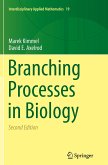This book develops the theory of continuous and discrete stochastic processes within the context of cell biology. A wide range of biological topics are covered including normal and anomalous diffusion in complex cellular environments, stochastic ion channels and excitable systems, stochastic calcium signaling, molecular motors, intracellular transport, signal transduction, bacterial chemotaxis, robustness in gene networks, genetic switches and oscillators, cell polarization, polymerization, cellular length control, and branching processes. The book also provides a pedagogical introduction to the theory of stochastic process - Fokker Planck equations, stochastic differential equations, master equations and jump Markov processes, diffusion approximations and the system size expansion, first passage time problems, stochastic hybrid systems, reaction-diffusion equations, exclusion processes, WKB methods, martingales and branching processes, stochastic calculus, and numerical methods. Thistext is primarily aimed at graduate students and researchers working in mathematical biology and applied mathematicians interested in stochastic modeling. Applied probabilists and theoretical physicists should also find it of interest. It assumes no prior background in statistical physics and introduces concepts in stochastic processes via motivating biological applications. The book is highly illustrated and contains a large number of examples and exercises that further develop the models and ideas in the body of the text. It is based on a course that the author has taught at the University of Utah for many years.
"This nearly 700-page volume is an impressive account of a 'second wave' in the broad field known as mathematical biology. ... I say 'Bravo!' Bressloff's book is a superb resource for applied mathematicians interested in teaching and/or research in this field." (John Adam, Mathematical Reviews, February, 2016)








